2004 BMW 645CI COUPE&CONVERTIBLE ECU
[x] Cancel search: ECUPage 3 of 216
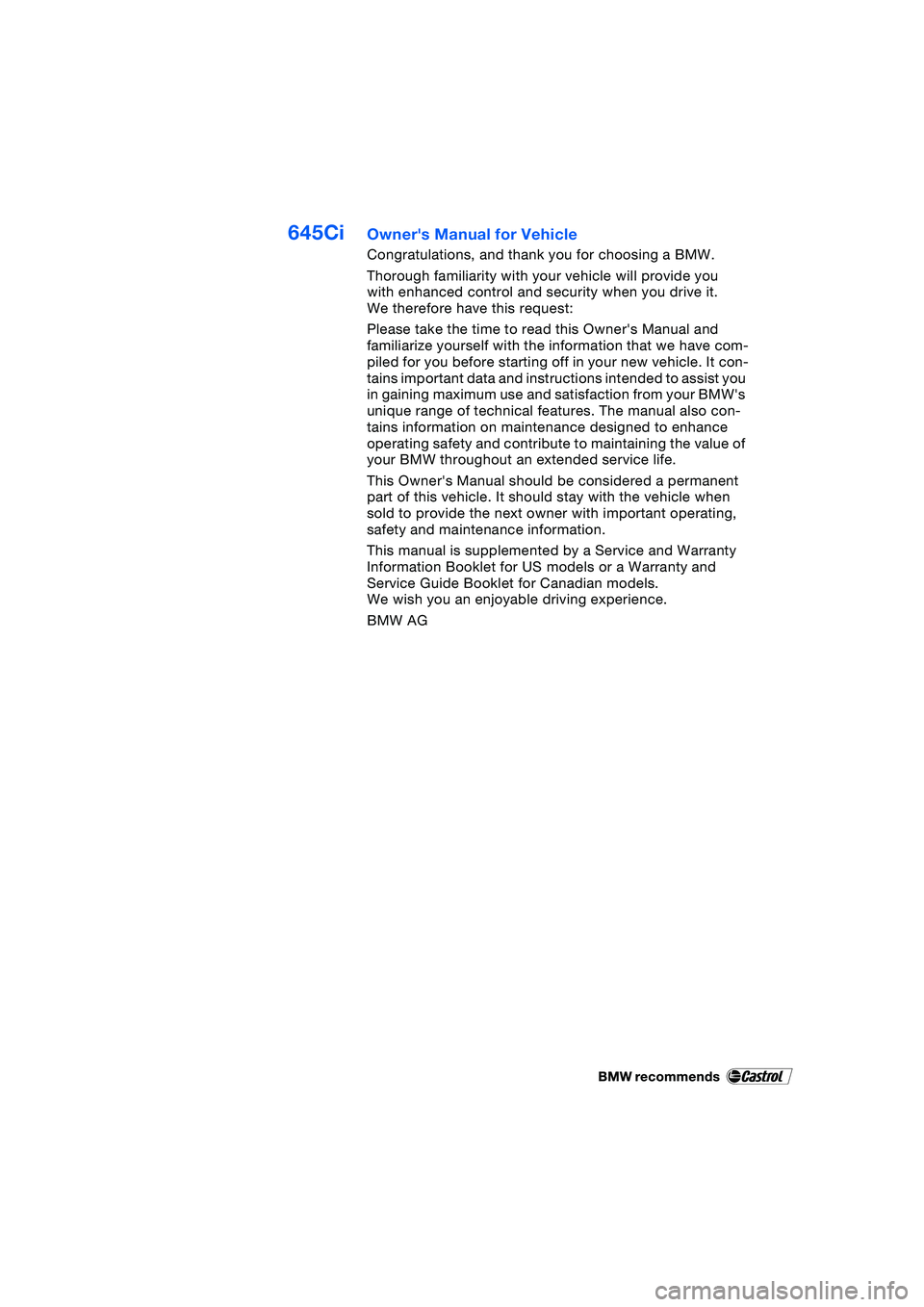
645CiOwner's Manual for Vehicle
Congratulations, and thank you for choosing a BMW.
Thorough familiarity with your vehicle will provide you
with enhanced control and security when you drive it.
We therefore have this request:
Please take the time to read this Owner's Manual and
familiarize yourself with the information that we have com-
piled for you before starting off in your new vehicle. It con-
tains important data and instructions intended to assist you
in gaining maximum use and satisfaction from your BMW's
unique range of technical features. The manual also con-
tains information on maintenance designed to enhance
operating safety and contribute to maintaining the value of
your BMW throughout an extended service life.
This Owner's Manual should be considered a permanent
part of this vehicle. It should stay with the vehicle when
sold to provide the next owner with important operating,
safety and maintenance information.
This manual is supplemented by a Service and Warranty
Information Booklet for US models or a Warranty and
Service Guide Booklet for Canadian models.
We wish you an enjoyable driving experience.
BMW AG
Page 20 of 216
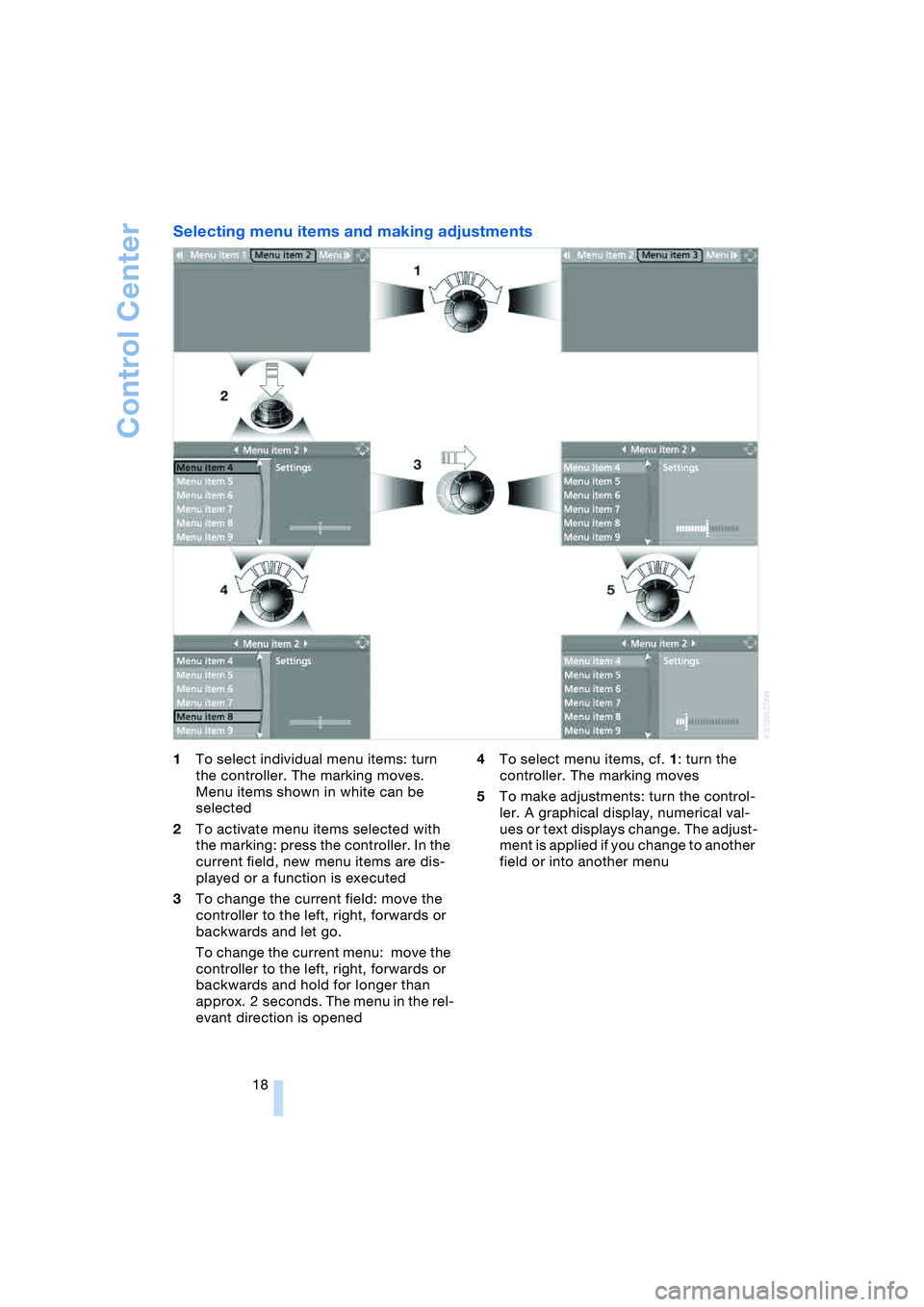
Control Center
18
Selecting menu items and making adjustments
1To select individual menu items: turn
the controller. The marking moves.
Menu items shown in white can be
selected
2To activate menu items selected with
the marking: press the controller. In the
current field, new menu items are dis-
played or a function is executed
3To change the current field: move the
controller to the left, right, forwards or
backwards and let go.
To change the current menu: move the
controller to the left, right, forwards or
backwards and hold for longer than
approx. 2 seconds. The menu in the rel-
evant direction is opened4To select menu items, cf. 1: turn the
controller. The marking moves
5To make adjustments: turn the control-
ler. A graphical display, numerical val-
ues or text displays change. The adjust-
ment is applied if you change to another
field or into another menu
Page 30 of 216
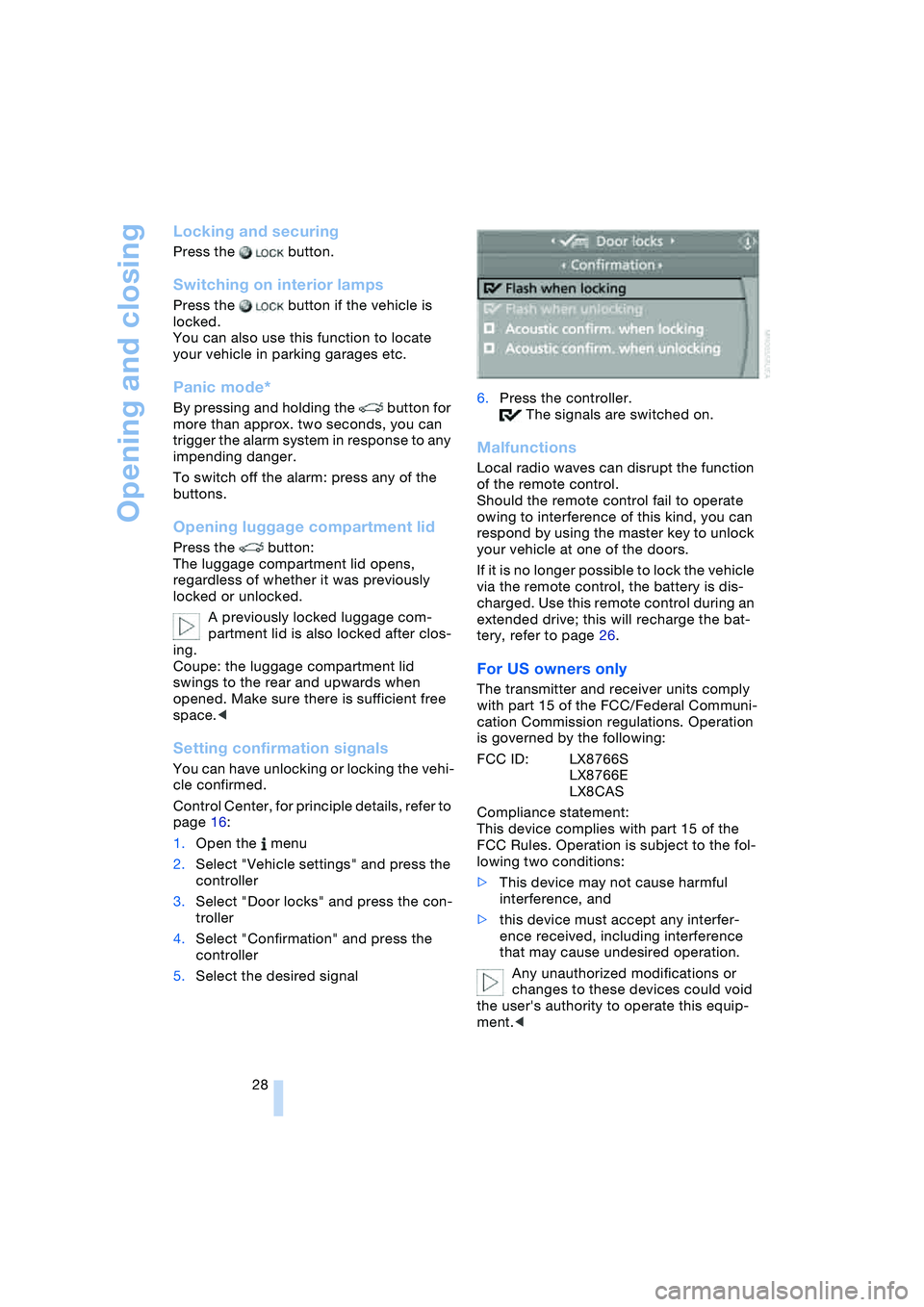
Opening and closing
28
Locking and securing
Press the button.
Switching on interior lamps
Press the button if the vehicle is
locked.
You can also use this function to locate
your vehicle in parking garages etc.
Panic mode*
By pressing and holding the button for
more than approx. two seconds, you can
trigger the alarm system in response to any
impending danger.
To switch off the alarm: press any of the
buttons.
Opening luggage compartment lid
Press the button:
The luggage compartment lid opens,
regardless of whether it was previously
locked or unlocked.
A previously locked luggage com-
partment lid is also locked after clos-
ing.
Coupe: the luggage compartment lid
swings to the rear and upwards when
opened. Make sure there is sufficient free
space.<
Setting confirmation signals
You can have unlocking or locking the vehi-
cle confirmed.
Control Center, for principle details, refer to
page 16:
1.Open the menu
2.Select "Vehicle settings" and press the
controller
3.Select "Door locks" and press the con-
troller
4.Select "Confirmation" and press the
controller
5.Select the desired signal6.Press the controller.
The signals are switched on.
Malfunctions
Local radio waves can disrupt the function
of the remote control.
Should the remote control fail to operate
owing to interference of this kind, you can
respond by using the master key to unlock
your vehicle at one of the doors.
If it is no longer possible to lock the vehicle
via the remote control, the battery is dis-
charged. Use this remote control during an
extended drive; this will recharge the bat-
tery, refer to page 26.
For US owners only
The transmitter and receiver units comply
with part 15 of the FCC/Federal Communi-
cation Commission regulations. Operation
is governed by the following:
FCC ID: LX8766S
LX8766E
LX8CAS
Compliance statement:
This device complies with part 15 of the
FCC Rules. Operation is subject to the fol-
lowing two conditions:
>This device may not cause harmful
interference, and
>this device must accept any interfer-
ence received, including interference
that may cause undesired operation.
Any unauthorized modifications or
changes to these devices could void
the user's authority to operate this equip-
ment.<
Page 34 of 216
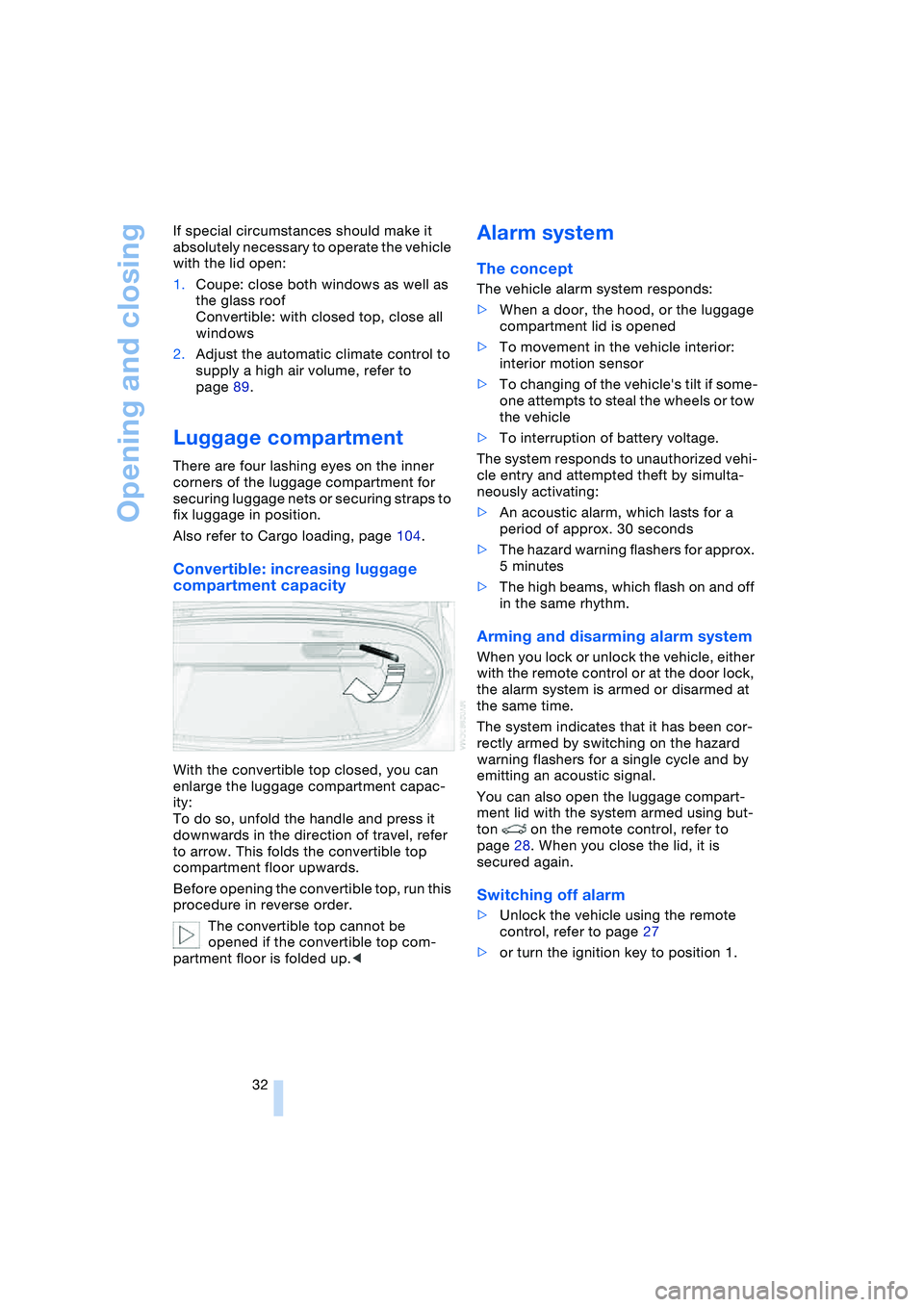
Opening and closing
32 If special circumstances should make it
absolutely necessary to operate the vehicle
with the lid open:
1.Coupe: close both windows as well as
the glass roof
Convertible: with closed top, close all
windows
2.Adjust the automatic climate control to
supply a high air volume, refer to
page 89.
Luggage compartment
There are four lashing eyes on the inner
corners of the luggage compartment for
securing luggage nets or securing straps to
fix luggage in position.
Also refer to Cargo loading, page 104.
Convertible: increasing luggage
compartment capacity
With the convertible top closed, you can
enlarge the luggage compartment capac-
ity:
To do so, unfold the handle and press it
downwards in the direction of travel, refer
to arrow. This folds the convertible top
compartment floor upwards.
Before opening the convertible top, run this
procedure in reverse order.
The convertible top cannot be
opened if the convertible top com-
partment floor is folded up.<
Alarm system
The concept
The vehicle alarm system responds:
>When a door, the hood, or the luggage
compartment lid is opened
>To movement in the vehicle interior:
interior motion sensor
>To changing of the vehicle's tilt if some-
one attempts to steal the wheels or tow
the vehicle
>To interruption of battery voltage.
The system responds to unauthorized vehi-
cle entry and attempted theft by simulta-
neously activating:
>An acoustic alarm, which lasts for a
period of approx. 30 seconds
>The hazard warning flashers for approx.
5 minutes
>The high beams, which flash on and off
in the same rhythm.
Arming and disarming alarm system
When you lock or unlock the vehicle, either
with the remote control or at the door lock,
the alarm system is armed or disarmed at
the same time.
The system indicates that it has been cor-
rectly armed by switching on the hazard
warning flashers for a single cycle and by
emitting an acoustic signal.
You can also open the luggage compart-
ment lid with the system armed using but-
ton on the remote control, refer to
page 28. When you close the lid, it is
secured again.
Switching off alarm
>Unlock the vehicle using the remote
control, refer to page 27
>or turn the ignition key to position 1.
Page 39 of 216
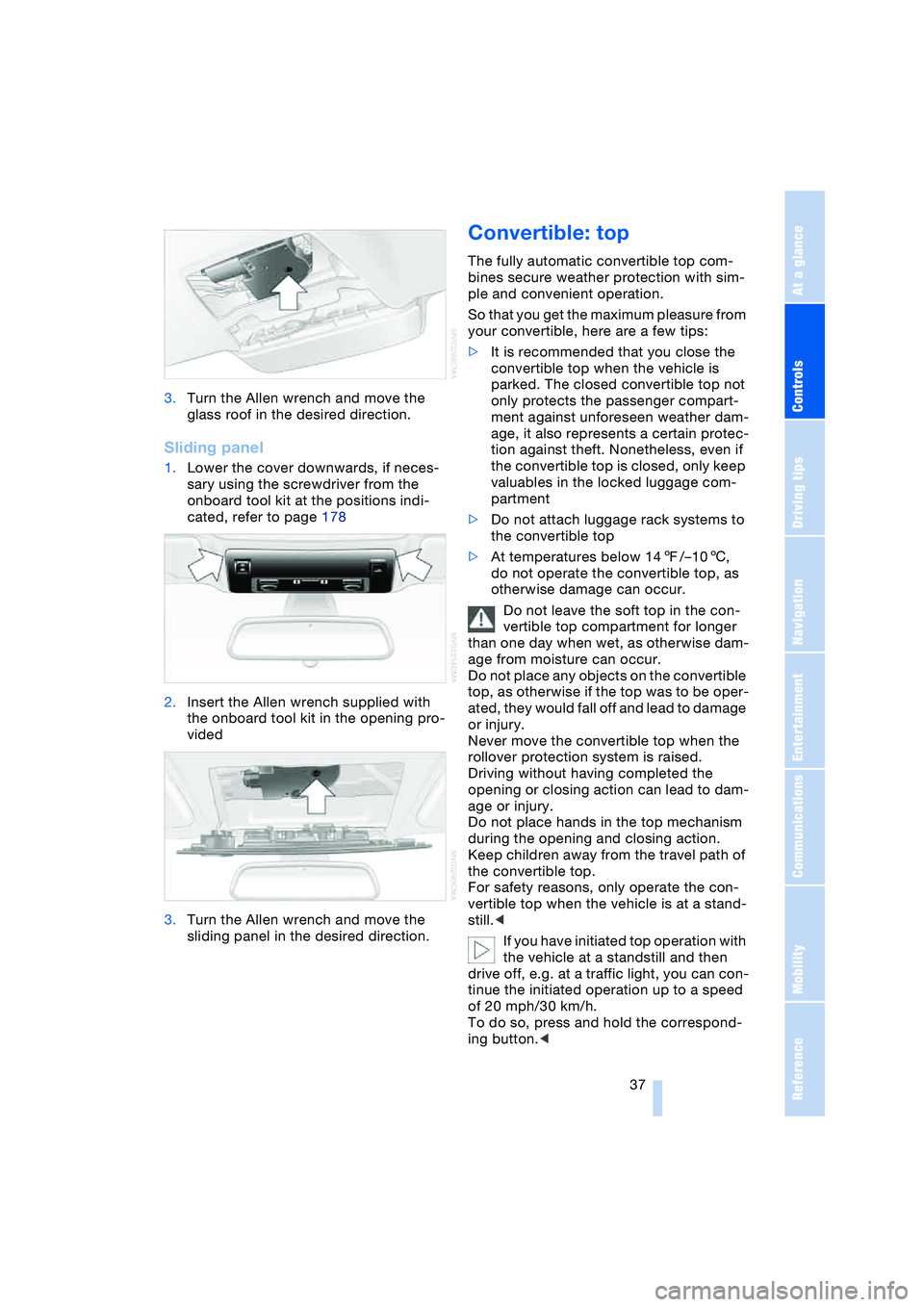
Controls
37Reference
At a glance
Driving tips
Communications
Navigation
Entertainment
Mobility
3.Turn the Allen wrench and move the
glass roof in the desired direction.
Sliding panel
1.Lower the cover downwards, if neces-
sary using the screwdriver from the
onboard tool kit at the positions indi-
cated, refer to page 178
2.Insert the Allen wrench supplied with
the onboard tool kit in the opening pro-
vided
3.Turn the Allen wrench and move the
sliding panel in the desired direction.
Convertible: top
The fully automatic convertible top com-
bines secure weather protection with sim-
ple and convenient operation.
So that you get the maximum pleasure from
your convertible, here are a few tips:
>It is recommended that you close the
convertible top when the vehicle is
parked. The closed convertible top not
only protects the passenger compart-
ment against unforeseen weather dam-
age, it also represents a certain protec-
tion against theft. Nonetheless, even if
the convertible top is closed, only keep
valuables in the locked luggage com-
partment
>Do not attach luggage rack systems to
the convertible top
>At temperatures below 147/–106,
do not operate the convertible top, as
otherwise damage can occur.
Do not leave the soft top in the con-
vertible top compartment for longer
than one day when wet, as otherwise dam-
age from moisture can occur.
Do not place any objects on the convertible
top, as otherwise if the top was to be oper-
ated, they would fall off and lead to damage
or injury.
Never move the convertible top when the
rollover protection system is raised.
Driving without having completed the
opening or closing action can lead to dam-
age or injury.
Do not place hands in the top mechanism
during the opening and closing action.
Keep children away from the travel path of
the convertible top.
For safety reasons, only operate the con-
vertible top when the vehicle is at a stand-
still.<
If you have initiated top operation with
the vehicle at a standstill and then
drive off, e.g. at a traffic light, you can con-
tinue the initiated operation up to a speed
of 20 mph/30 km/h.
To do so, press and hold the correspond-
ing button.<
Page 43 of 216
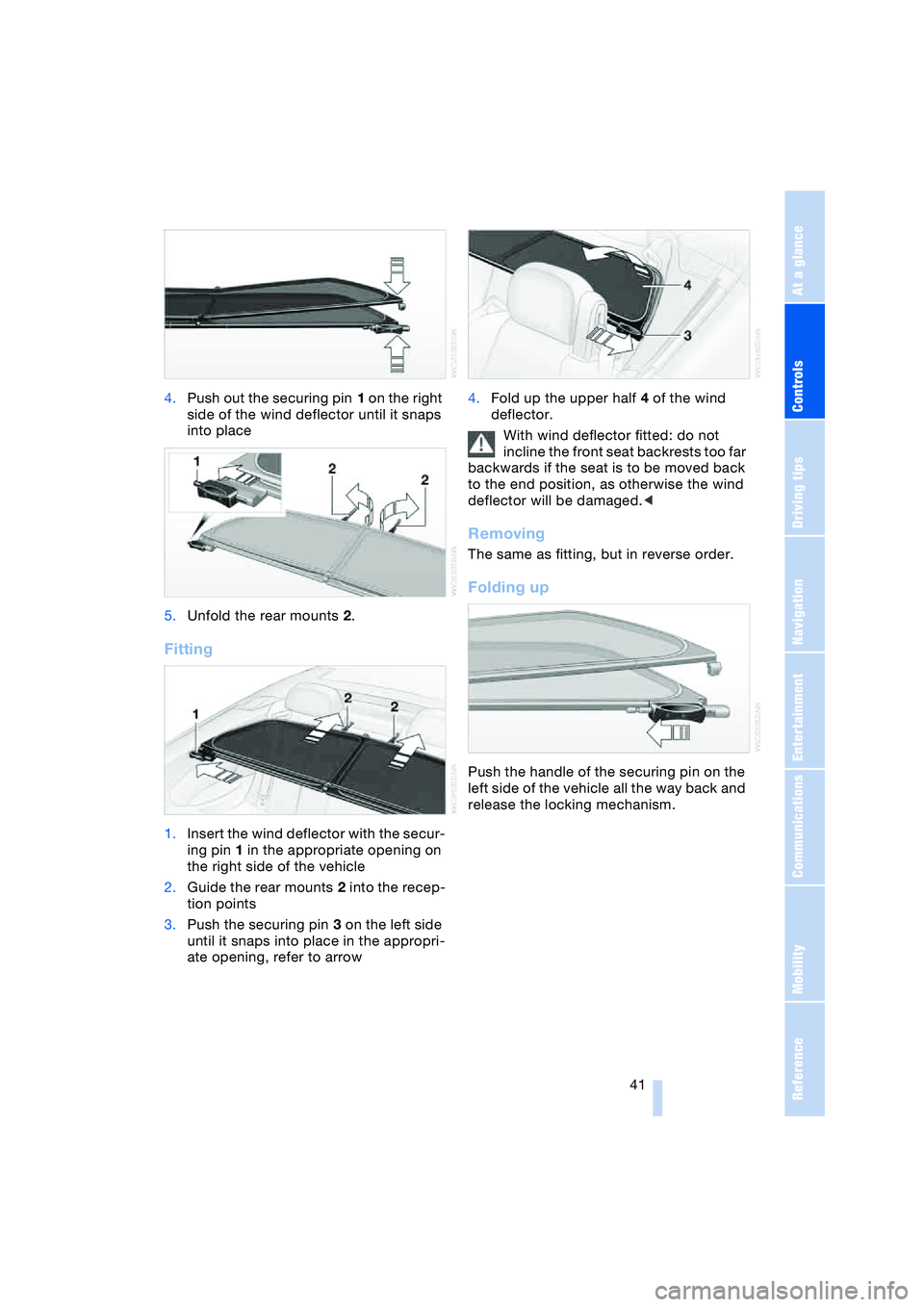
Controls
41Reference
At a glance
Driving tips
Communications
Navigation
Entertainment
Mobility
4.Push out the securing pin 1 on the right
side of the wind deflector until it snaps
into place
5.Unfold the rear mounts 2.
Fitting
1.Insert the wind deflector with the secur-
ing pin 1 in the appropriate opening on
the right side of the vehicle
2.Guide the rear mounts 2 into the recep-
tion points
3.Push the securing pin 3 on the left side
until it snaps into place in the appropri-
ate opening, refer to arrow4.Fold up the upper half 4 of the wind
deflector.
With wind deflector fitted: do not
incline the front seat backrests too far
backwards if the seat is to be moved back
to the end position, as otherwise the wind
deflector will be damaged.<
Removing
The same as fitting, but in reverse order.
Folding up
Push the handle of the securing pin on the
left side of the vehicle all the way back and
release the locking mechanism.
Page 53 of 216
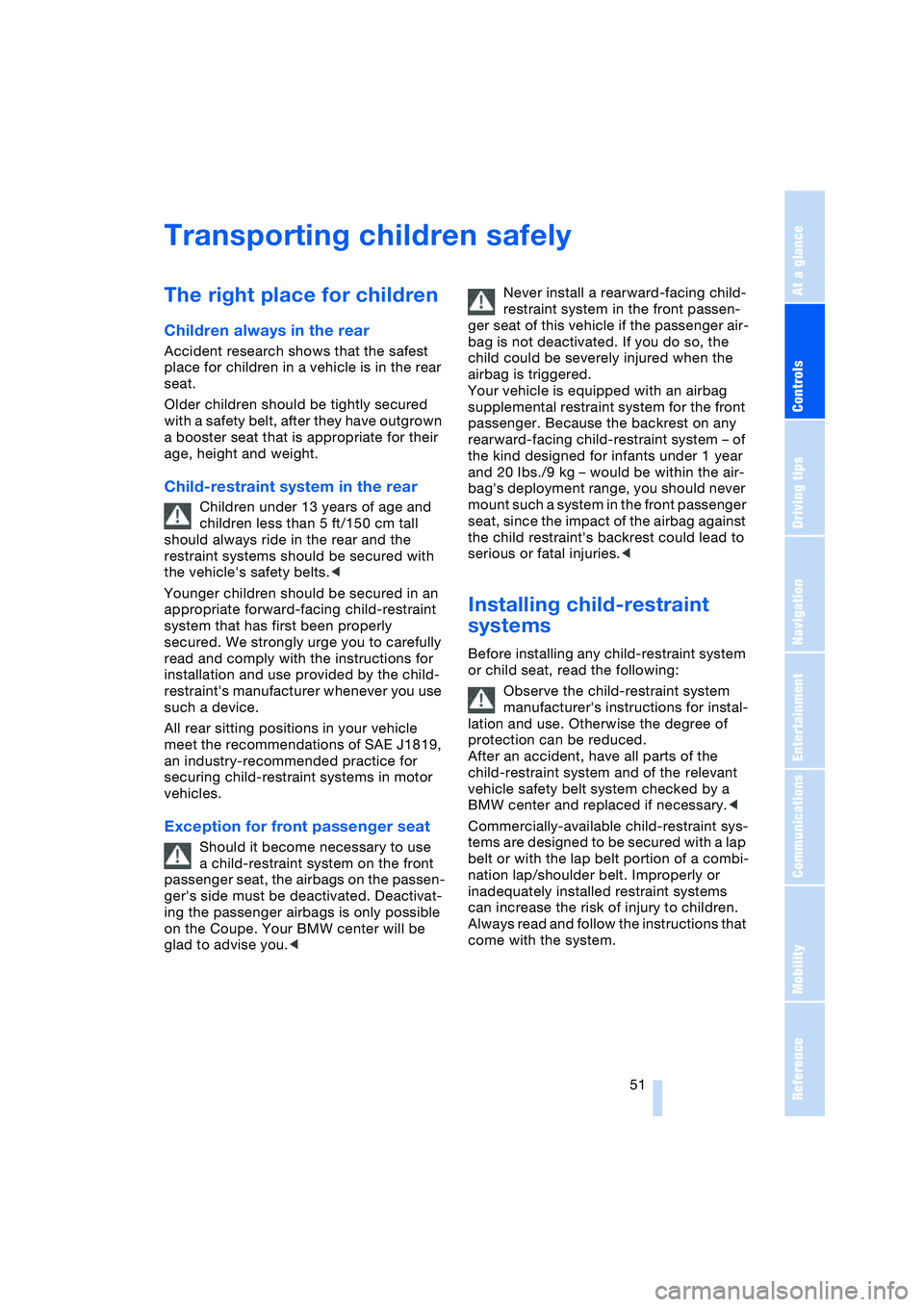
Controls
51Reference
At a glance
Driving tips
Communications
Navigation
Entertainment
Mobility
Transporting children safely
The right place for children
Children always in the rear
Accident research shows that the safest
place for children in a vehicle is in the rear
seat.
Older children should be tightly secured
with a safety belt, after they have outgrown
a booster seat that is appropriate for their
age, height and weight.
Child-restraint system in the rear
Children under 13 years of age and
children less than 5 ft/150 cm tall
should always ride in the rear and the
restraint systems should be secured with
the vehicle's safety belts.<
Younger children should be secured in an
appropriate forward-facing child-restraint
system that has first been properly
secured. We strongly urge you to carefully
read and comply with the instructions for
installation and use provided by the child-
restraint's manufacturer whenever you use
such a device.
All rear sitting positions in your vehicle
meet the recommendations of SAE J1819,
an industry-recommended practice for
securing child-restraint systems in motor
vehicles.
Exception for front passenger seat
Should it become necessary to use
a child-restraint system on the front
passenger seat, the airbags on the passen-
ger's side must be deactivated. Deactivat-
ing the passenger airbags is only possible
on the Coupe. Your BMW center will be
glad to advise you.
ger seat of this vehicle if the passenger air-
bag is not deactivated. If you do so, the
child could be severely injured when the
airbag is triggered.
Your vehicle is equipped with an airbag
supplemental restraint system for the front
passenger. Because the backrest on any
rearward-facing child-restraint system – of
the kind designed for infants under 1 year
and 20 Ibs./9 kg – would be within the air-
bag's deployment range, you should never
mount such a system in the front passenger
seat, since the impact of the airbag against
the child restraint's backrest could lead to
serious or fatal injuries.<
Installing child-restraint
systems
Before installing any child-restraint system
or child seat, read the following:
Observe the child-restraint system
manufacturer's instructions for instal-
lation and use. Otherwise the degree of
protection can be reduced.
After an accident, have all parts of the
child-restraint system and of the relevant
vehicle safety belt system checked by a
BMW center and replaced if necessary.<
Commercially-available child-restraint sys-
tems are designed to be secured with a lap
belt or with the lap belt portion of a combi-
nation lap/shoulder belt. Improperly or
inadequately installed restraint systems
can increase the risk of injury to children.
Always read and follow the instructions that
come with the system.
Page 54 of 216
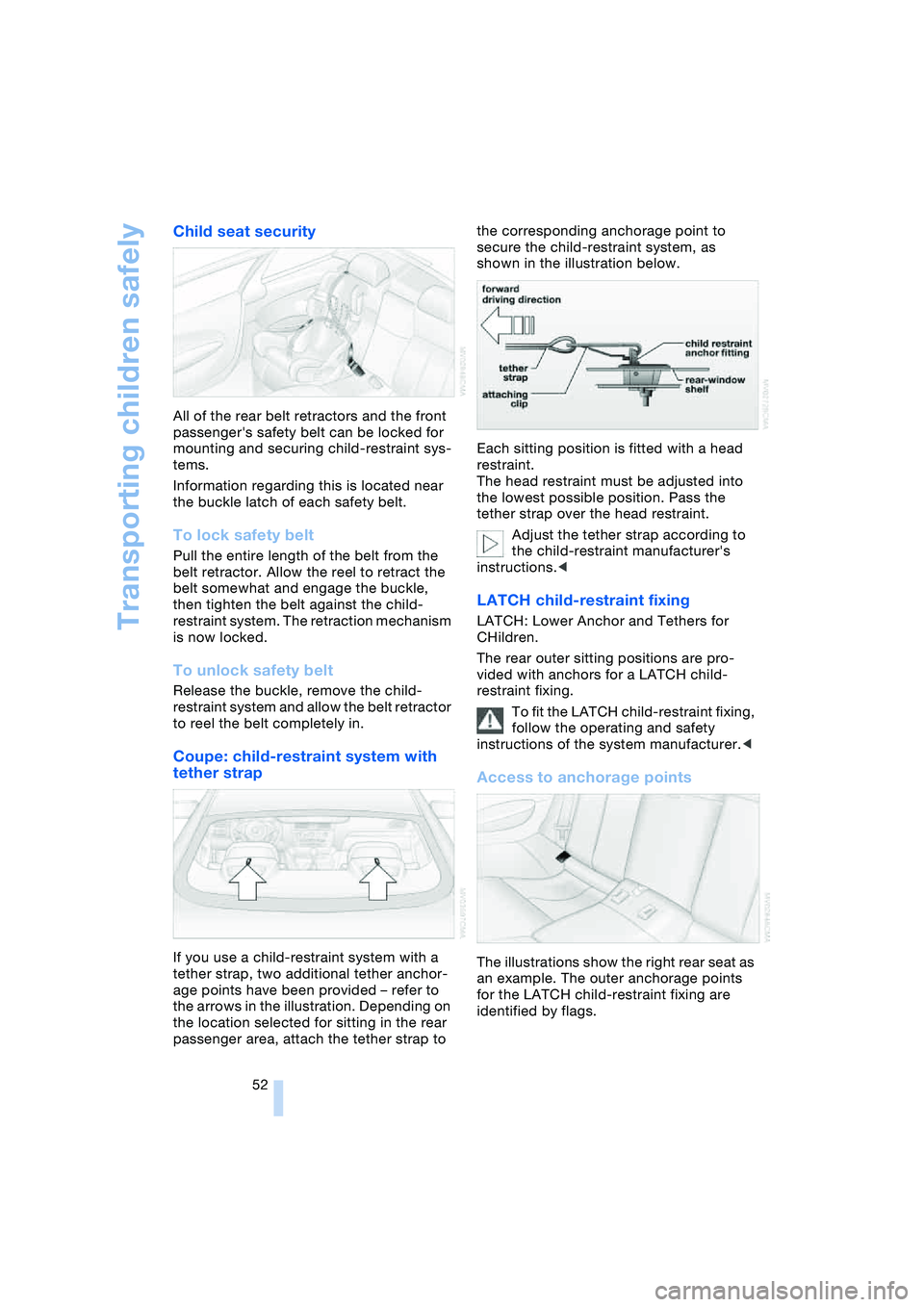
Transporting children safely
52
Child seat security
All of the rear belt retractors and the front
passenger's safety belt can be locked for
mounting and securing child-restraint sys-
tems.
Information regarding this is located near
the buckle latch of each safety belt.
To lock safety belt
Pull the entire length of the belt from the
belt retractor. Allow the reel to retract the
belt somewhat and engage the buckle,
then tighten the belt against the child-
restraint system. The retraction mechanism
is now locked.
To unlock safety belt
Release the buckle, remove the child-
restraint system and allow the belt retractor
to reel the belt completely in.
Coupe: child-restraint system with
tether strap
If you use a child-restraint system with a
tether strap, two additional tether anchor-
age points have been provided – refer to
the arrows in the illustration. Depending on
the location selected for sitting in the rear
passenger area, attach the tether strap to the corresponding anchorage point to
secure the child-restraint system, as
shown in the illustration below.
Each sitting position is fitted with a head
restraint.
The head restraint must be adjusted into
the lowest possible position. Pass the
tether strap over the head restraint.
Adjust the tether strap according to
the child-restraint manufacturer's
instructions.<
LATCH child-restraint fixing
LATCH: Lower Anchor and Tethers for
CHildren.
The rear outer sitting positions are pro-
vided with anchors for a LATCH child-
restraint fixing.
To fit the LATCH child-restraint fixing,
follow the operating and safety
instructions of the system manufacturer.<
Access to anchorage points
The illustrations show the right rear seat as
an example. The outer anchorage points
for the LATCH child-restraint fixing are
identified by flags.